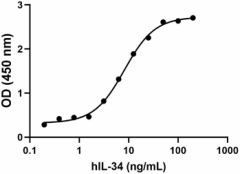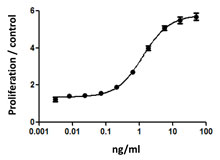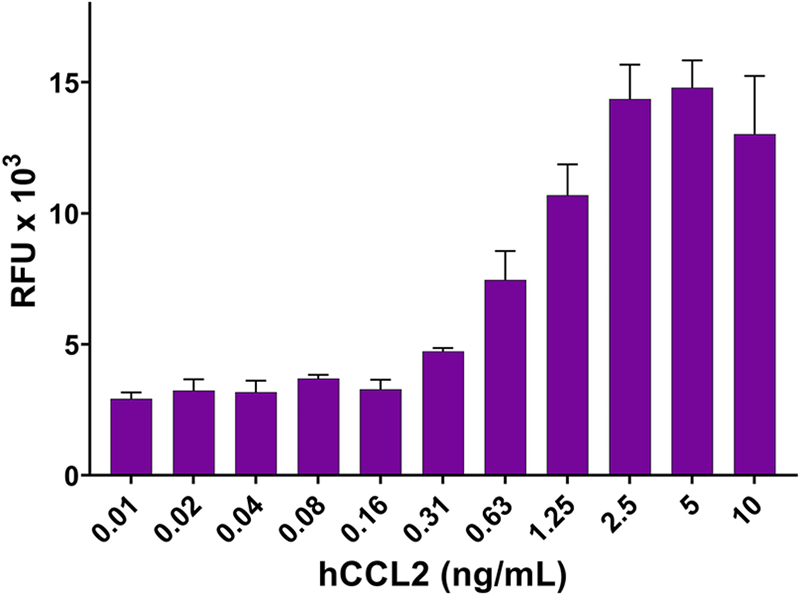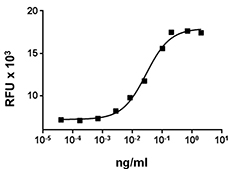- Regulatory Status
- RUO
- Other Names
- IL34, C16orf77 homolog
- Ave. Rating
- Submit a Review
- Product Citations
- publications

-

Human IL-34 induces MCP-1 (CCL2) production in human peripheral blood mononuclear cells (PBMC) in a dose-dependent manner. The ED50 for this effect is 4 - 20 ng/mL. -

Recombinant human IL-34 induces MCP-1 production in human PBMCs in a dose-dependent manner. BioLegend’s protein was compared side-by-side to the leading competitor’s equivalent product.
Human IL-34 shares a sequence identity of 99.6%, 72% and 71% with chimpanzee, rat, and mouse IL-34, respectively, on the amino acid level. The IL-34 gene is syntenic in the human, chimpanzee, rat, and mouse genomes. IL-34 has no apparent consensus structural domain or motif, and does not share sequence homology with M-CSF; nevertheless, it binds to the CSFR. These two cytokines are not identical in biological activity and signal activation. IL-34 and CSF show an equivalent ability to support cell growth or survival. However, these cytokines have differing ability to induce the production of chemokines (MCP-1 and eotaxin-2) in primary macrophages, the morphological change in TF-1-fms cells, and the migration of J774A.1 cells. The use of monoclonal antibodies against the CSFR suggests a differential domain binding in the receptor to IL-34 and CSF and, as a result, different bioactivities and signal activation kinetics/strength are produced for these cytokines.
Product DetailsProduct Details
- Source
- The human IL-34 (Accession# NM_152456.2: Met1 - Pro242 with a C-terminal 8His tag) was expressed CHO cells.
- Molecular Mass
- The 235 amino acid recombinant protein has a predicted molecular mass of 26.7 kD. The DTT-reduced protein migrates at approximately 40 kD, and the non-reduced protein migrates with slightly greater mobility by SDS-PAGE.
- Purity
- >95%, as determined by Coomassie stained SDS-PAGE.
- Formulation
- 0.22 µm filtered protein solution is in 10 mM NaH2PO4, 0.5 M NaCl, pH 7.4.
- Endotoxin Level
- Less than 0.01 ng per µg cytokine as determined by the LAL method.
- Concentration
- 10 and 25 µg sizes are bottled at 200 µg/mL. 100 µg size and larger sizes are lot-specific and bottled at the concentration indicated on the vial. To obtain lot-specific concentration and expiration, please enter the lot number in our Certificate of Analysis online tool.
- Storage & Handling
- Unopened vial can be stored between 2°C and 8°C for up to 2 weeks, at -20°C for up to six months, or at -70°C or colder until the expiration date. For maximum results, quick spin vial prior to opening. The protein can be aliquoted and stored at -20°C or colder. Stock solutions can also be prepared at 50 - 100 µg/mL in appropriate sterile buffer, carrier protein such as 0.2 - 1% BSA or HSA can be added when preparing the stock solution. Aliquots can be stored between 2°C and 8°C for up to one week and stored at -20°C or colder for up to 3 months. Avoid repeated freeze/thaw cycles.
- Activity
- Human IL-34 induces MCP-1 (CCL2) production in human peripheral blood mononuclear cells (PBMC) in a dose-dependent manner. The ED50 for this effect is 4 - 20 ng/mL.
- Application
-
Bioassay
- Application Notes
-
BioLegend carrier-free recombinant proteins provided in liquid format are shipped on blue-ice. Our comparison testing data indicates that when handled and stored as recommended, the liquid format has equal or better stability and shelf-life compared to commercially available lyophilized proteins after reconstitution. Our liquid proteins are verified in-house to maintain activity after shipping on blue ice and are backed by our 100% satisfaction guarantee. If you have any concerns, contact us at tech@biolegend.com.
- Product Citations
-
Antigen Details
- Structure
- Homodimer
- Distribution
-
IL-34 mRNA is expressed in different tissues, including spleen, heart, brain, lung, liver, kidney, thymus, testes, ovary, small intestine, prostate, and colon.
- Function
- IL-34 increases monocyte's viability, induces macrophage proliferation, and synergizes with other cytokines to generate macrophages and osteoclasts from cultured progenitors. IL-34 promotes the formation of the colony-forming unit-macrophage (CFU-M) in human bone marrow culture. IL-34 supports RANKL-induced osteoclastogenesis by promoting the adhesion and proliferation of osteoclast progenitors. Human IL-34 promotes the osteoclast differentiation from peripheral blood mononucleated cells. In addition, systematic administration of IL-34 to mouse increases the number of CD11b+ cells and reduces bone mass. IL-1β and TNF-α induce the expression of interleukin-34 mRNA in osteoblast. IL-34 is induced in macrophages infected with equine infectious anemia virus (EIAV).
- Interaction
- Macrophages, monocytes, myeloid cells.
- Ligand/Receptor
- CSF-1R.
- Biology Area
- Immunology, Innate Immunity, Stem Cells
- Molecular Family
- Cytokines/Chemokines
- Antigen References
-
1. Clanchy F, et al. 2006. J. Leukoc. Biol. 79:757.
2. Lin H, et al. 2008. Science 320:807.
3. Chihara T, et al. 2010. Cell. Death Differ. 17:1917.
4. Wei S, et al. 2010. J. Leukoc. Biol. 88:495.
5. Eda H, et al. 2010. Rheumatol. Int. epub.
6. Covaleda L, et al. 2010. Virology 397:217.
7. Chen Z, et al. 2011. PLoS One 6:e18689. - Gene ID
- 146433 View all products for this Gene ID
- Specificity (DOES NOT SHOW ON TDS):
- IL-34
- Specificity Alt (DOES NOT SHOW ON TDS):
- IL-34
- App Abbreviation (DOES NOT SHOW ON TDS):
- BA
- UniProt
- View information about IL-34 on UniProt.org
Related Pages & Pathways
Pages
Related FAQs
- Why choose BioLegend recombinant proteins?
-
• Each lot of product is quality-tested for bioactivity as indicated on the data sheet.
• Greater than 95% Purity or higher, tested on every lot of product.
• 100% Satisfaction Guarantee for quality performance, stability, and consistency.
• Ready-to-use liquid format saves time and reduces challenges associated with reconstitution.
• Bulk and customization available. Contact us.
• Learn more about our Recombinant Proteins. - How does the activity of your recombinant proteins compare to competitors?
-
We quality control each and every lot of recombinant protein. Not only do we check its bioactivity, but we also compare it against other commercially available recombinant proteins. We make sure each recombinant protein’s activity is at least as good as or better than the competition’s. In order to provide you with the best possible product, we ensure that our testing process is rigorous and thorough. If you’re curious and eager to make the switch to BioLegend recombinants, contact your sales representative today!
- What is the specific activity or ED50 of my recombinant protein?
-
The specific activity range of the protein is indicated on the product datasheets. Because the exact activity values on a per unit basis can largely fluctuate depending on a number of factors, including the nature of the assay, cell density, age of cells/passage number, culture media used, and end user technique, the specific activity is best defined as a range and we guarantee the specific activity of all our lots will be within the range indicated on the datasheet. Please note this only applies to recombinants labeled for use in bioassays. ELISA standard recombinant proteins are not recommended for bioassay usage as they are not tested for these applications.
- Have your recombinants been tested for stability?
-
Our testing shows that the recombinant proteins are able to withstand room temperature for a week without losing activity. In addition the recombinant proteins were also found to withstand four cycles of freeze and thaw without losing activity.
- Does specific activity of a recombinant protein vary between lots?
-
Specific activity will vary for each lot and for the type of experiment that is done to validate it, but all passed lots will have activity within the established ED50 range for the product and we guarantee that our products will have lot-to-lot consistency. Please conduct an experiment-specific validation to find the optimal ED50 for your system.
- How do you convert activity as an ED50 in ng/ml to a specific activity in Units/mg?
-
Use formula Specific activity (Units/mg) = 10^6/ ED50 (ng/mL)














Follow Us